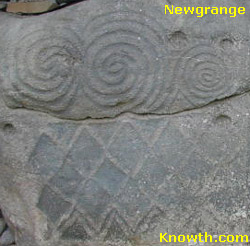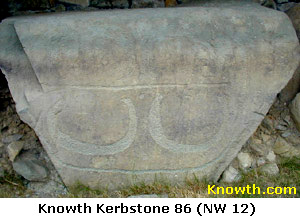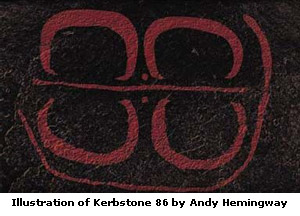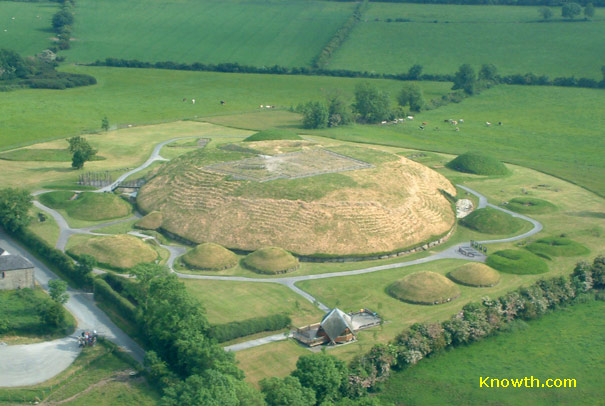Spirals within Spirals, Stones have Stories to Tell
A personal essay by James Nemec (1953-2011) - Page 4 We
walked to the contemporary eco-shelter to check in. My friend said that she actually
knew who had designed this eco-shelter, and then said, very excitedly, that they designed
it by first asking the surrounding land what it would like made there? I could have thought
this annoying, but then I recalled a Discovery Channel show, My Architect, about the
Pennsylvania architect, Louis I. Khan, who designed The Salk Institute and Yale University of Art.
We
walked to the contemporary eco-shelter to check in. My friend said that she actually
knew who had designed this eco-shelter, and then said, very excitedly, that they designed
it by first asking the surrounding land what it would like made there? I could have thought
this annoying, but then I recalled a Discovery Channel show, My Architect, about the
Pennsylvania architect, Louis I. Khan, who designed The Salk Institute and Yale University of Art.
There were times when Khan would actually ask his building materials what kind of structures they would like to be made into? The response from his materials might be an arch or a stairway. Who knows? Maybe he got this idea from Frank Lloyd Wright.
However, what is it that can happen when we take the time to ask, listen, and wait for a response? Were her friends really onto something? I couldn't figure out exactly what, at the time, and let it go as a bit of local color and information.
The boy with red hair handed back my tin whistle. He graciously bowed as I applauded him once more. I liked him. He joined his mother to meet our tired tour guide. I could tell this woman had led one too many tours through Knowth that day! She had full, dark hair and a winnowing voice in an accent I could not place. Even so, as our tour guide spoke, my imagination started to work again. She led us to a series of large, framed pictures that depicted the site's history as a panorama. There is a difference in hearing about a place and making the journey ourselves. I couldn't shake the peculiar feeling that the mounds were built out of a sense of necessity; perhaps the ancients knew the human race would one day fall into conflict, the kind of conflict that is death, or sleep. Perhaps they wanted us to at least, remember.
What was it that they wanted us to remember? I thought.
"Well, here we are," said Eileen.
"Yes, here we are."
"Well, here we are," said Eileen.
"Yes, here we are."
From my journal, with our guide talking a mile a minute, here is the two-second history of Knowth recounted by a tourist:
-
First, there were the prehistoric people who built the huge mounds, Knowth and Newgrange, both
at about the same time, plus or minus one hundred years, around 3000 BC.
-
Then there was a time of quiet for a mere thousand years after which a small
race settled here, the Bronze Age Beaker people, who seemed to leave the mounds alone for the most part.
-
After the Beaker people went on their merry way, the famed Celts settled here and built
structures around the mounds. This was also a time of Celtic military expansion and trade where the
centre of Celtic Kingdom would be positioned at the nearby Hill of
Tara.
-
The Celts disappeared when Saint Patrick came on the scene at about 453 AD. I had
almost forgotten about Saint Patrick. How could I have forgotten him? I was in Ireland!
He is of course the famous Irish monk who retuned to the Emerald Isle to drive the snakes
out of Ireland. It was about this point in the talk when I thought, "Saint Patrick
did not drive the snakes out of Ireland." It was another spiralling insight, and for
the moment, I let it go as curious. Our tour guide continued her weary, well- practiced
introduction to the mound of Knowth.
- After Saint Patrick, around 1100 to 1200 AD, it was the Normans and their conquests. Like the Celts and the early Christians, the Normans built their structures on the top of the mound of Knowth and around the mound. But the Normans intermarried with people of the Hills, said our erstwhile guide, and after a short time of a few years abandoned their structures here. She then asked us to follow her to the great mound itself. Eileen and I trailed behind. It didn't seem we were allowed to say anything.
"Keep up!" called the tour guide.
I walked on. But in that moment of stopping, it was as if I could sense the different layers of energy around the mound of Knowth. It was also as if I could sense each discreet era. To me, the cleanest energy, the energy that was the clearest and least filled with the debris of emotional conflict and time, was that of the original builders, not that of the Normans, not even that of the Celts. What was it about this feeling of good energy? It felt almost a transfusion of the fresh and the new. It was like bathing in clear, clean water, water that had no pollution in it or taint. It was a wellspring of energy available to all who would travel to Knowth and simply be open to its being there. Eileen also makes her living as a healer and intuitive bodyworker. "The original builders had the cleanest energy," I whispered to her. She smiled, "I got that too," she said. I felt encouraged. She was also tuned in now. We were setting up an attunement with the place, our secret!
Then it troubled me. How could this be? Why wasn't all the energy here, the whole field of energy, clean, fresh and new? I had not expected to feel anything, certainly nothing like this. Since I was feeling something, I wondered why the cleanest energy would seem that of the original builders, not of the happy Celts. I knew who the Celts were, or thought I did. I had heard of the Celtic lore since the 1970's and 1980's in the U.S., and how they respected and worked with the Earth. And I loved the Van Morrison's song, "Celtic Ray." As an eco-friendly kind of guy, I cherished a secret admiration for the Celts and their natural, earthy ways.
I then thought how the poet, William Butler Yeats had long looked into the Celtic lore for his answers. I had studied Yeats in high school and college and had recently been to the museum in Dublin to see his special exhibit. My friend could quote his poem, "The Lake Isle of Innisfree," off the top of her head. "I will arise and go now, and go to Innisfree/And a small cabin build there, of clay and wattles made. /Nine bean-rows will I have there, a hive for the honeybee,/And live alone in the bee-loud glade."
Yeats had written great poems from this lore, made charts and diagrams from it, but dare I say, what was in it for him? What did he find in it to satisfy his own soul's longing? I shocked myself with this thought. Again, all of these very subjective thoughts and feelings rushed through my mind as the main motif on the rocks surrounding the mound looked back at me: the spirals.
Did history travel in a straight line, from A to Zed? Or did it circle and flow and spiral?
I was too much in my head.
 The
tour guide stopped us in front of one of the large, flat rocks that surrounded the mound.
She said these rocks were generally called, in the Irish, kerbstones. The giant boulders,
each weighing about 5 tons, were carried or rolled by logs from a quarry at Tullyallen
almost 9 miles away! Once upon a time these heavy
stones were exposed and supported the outer edges of the great mound in a circle.
Our guide said they had been covered over with dirt by early settlers, perhaps to make
a smooth hill out of the mound.
The
tour guide stopped us in front of one of the large, flat rocks that surrounded the mound.
She said these rocks were generally called, in the Irish, kerbstones. The giant boulders,
each weighing about 5 tons, were carried or rolled by logs from a quarry at Tullyallen
almost 9 miles away! Once upon a time these heavy
stones were exposed and supported the outer edges of the great mound in a circle.
Our guide said they had been covered over with dirt by early settlers, perhaps to make
a smooth hill out of the mound.The stones were preserved in tact until their recent excavation. Also, the stones themselves were now supported and reinforced at the rear with a generous government restoration project for Knowth.
She then said, "Tell me, so what is this? What do you see?"
No one spoke. I scratched my chin in bewilderment. On this one kerbstone were two semi-circles that faced up, and which at first, I thought were two upward facing crescent moons. But there was a long, horizontal line above them at the centre of the stone that travelled around on an oblique and along the bottom of the stone. At the centre of the two semi-circles, and just below the centre of the horizontal line, had been carved a single dot.
I volunteered, "Boats on a river?"
"Good answer," she said. "I haven't heard that in awhile. It could be one boat or two, or it could be something else. Can any of you figure this out? No one knows what it is."
I decided to shut up and listen.
"Good answer," she said. "I haven't heard that in awhile. It could be one boat or two, or it could be something else. Can any of you figure this out? No one knows what it is."
I decided to shut up and listen.
"There are two more semi-circles above these, and another dot above the one you see here, just above the line," she said, "if you look very closely. Does anyone see that?"
Maybe I could. I didn't know. Then it came into focus. It was very faint. It was a set of four semi-circles divided by one horizontal line with two discreet dots, above and below. I didn't know at the moment that this would be a stone hard to forget.

Megalithic art is only art that is done on stone, she said. The word comes from the Greek word, megalithos, which means, "big stone."
The unusual designs were created by ancients by using either a sharp piece of flint, or by using sharpened flint with a stone hammer to chisel away at the stone's surface. Archaeologists call these methods of carving either picking or pocking.
Picking or pocking, I thought. Makes sense.
She then directed us to another stone carving. We all followed her dutifully. "Here's one we think we know the answer to." It had waving or zigzagging ascending and descending lines, one above the other. "And we only know this recently. A scientist came here and pointed out that these lines symbolize the way the moon travels through its orbit. Have any of you heard of the lunar nodes? No one had ever seen this before." I looked up at the sky. It was late afternoon but the sun was still hot on the surrounding hills. How could the ancient builders have known that? I wondered.
Boyne Valley Private Day Tour
 Immerse yourself in the rich heritage and culture of the Boyne Valley with our full-day private tours.
Visit Newgrange World Heritage site, explore the Hill of Slane, where Saint Patrick famously lit the Paschal fire.
Discover the Hill of Tara, the ancient seat of power for the High Kings of Ireland.
Book Now
Immerse yourself in the rich heritage and culture of the Boyne Valley with our full-day private tours.
Visit Newgrange World Heritage site, explore the Hill of Slane, where Saint Patrick famously lit the Paschal fire.
Discover the Hill of Tara, the ancient seat of power for the High Kings of Ireland.
Book Now
Home
| Newgrange
| Knowth
| Dowth
| Hill of Tara
| Fourknocks
| Loughcrew
| More Places
| Labyrinths
| Local Info
| Art Works
| Articles
| Images
| Books
| Links
| Boyne Valley Tours
| Contact


